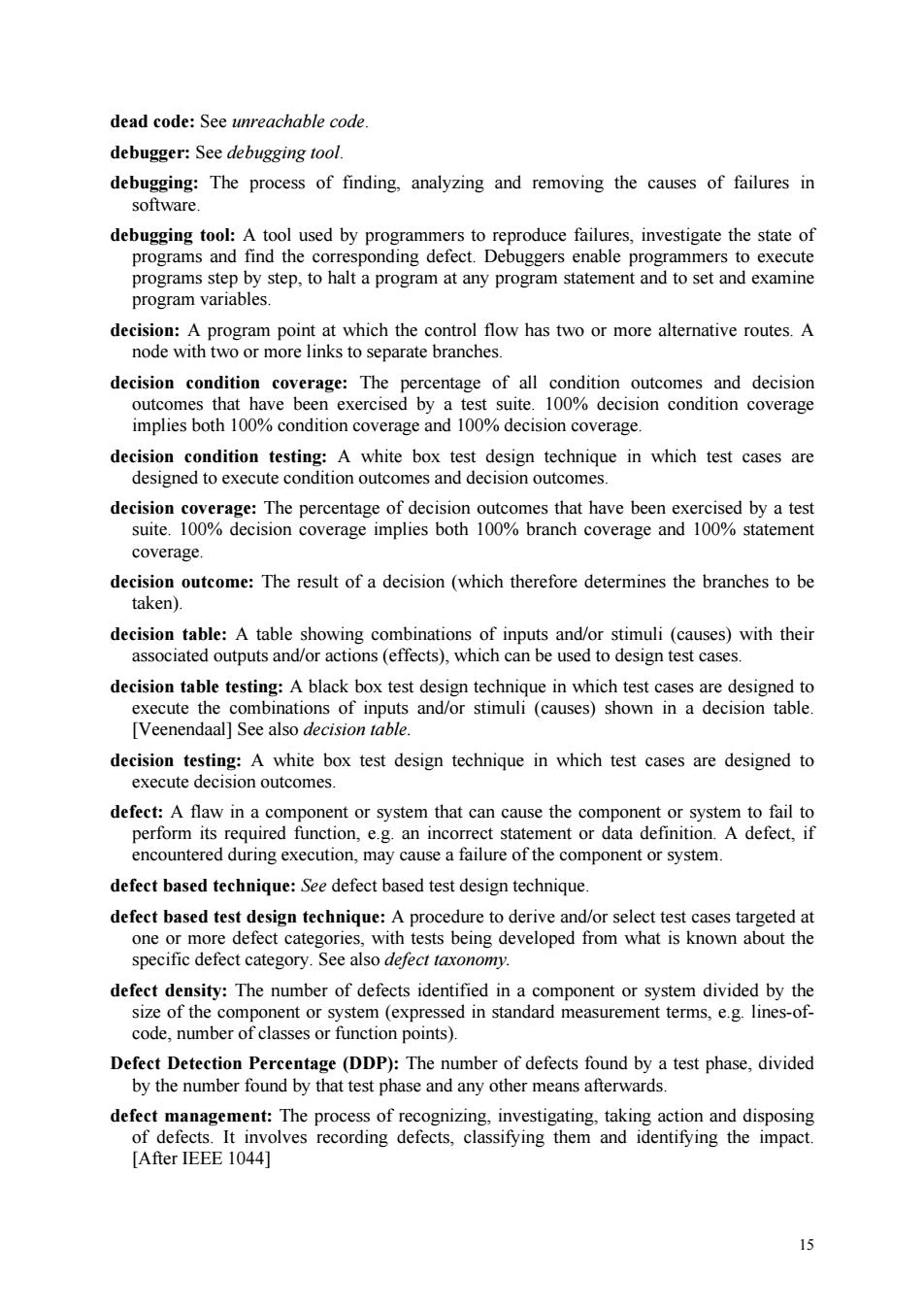正在加载图片...

dead code:See unreachable code. debugger:See debugging tool. debugging:The process of finding.analyzing and removing the causes of failures in softwar debugging tool:A tool used by programmers to reproduce failures,investigate the state of programs and find the corresponding defect.Debuggers enable programmers to execute programs step by step,to halt a program at any program statement and to set and examine program variables. ion:A flow has two or more alternative routes.A decision condition rage:The e of all condition and decision est suite 100%de ision conditior coverage implies both 100%condition coverage and 100%decision coverage. decision condition testing:A white box test design technique in which test cases are designed to execute condition outcomes and decision outcomes. iioncoverae mle othes that have been exer d by a test h coverage and 100%statement coverage decision outcome:The result of a decision(which therefore determines the branches to be taken). deeision table:A table showing combinations of inputs and/or stimuli(causes)with their associated outputs and/or actions(effects),which can be used to design test cases. decision table testing:A black box test design technique in which test cases are designed to execute the ations of input s and/or stimuli (causes)shown in a decision table [Veenendaal]See also decision table Awhite bo test design technquewhch test cases are designed defect:A flaw in a component or system that can cause the component or system to fail to perform its required function,e.g.an incorrect statement or data definition.A defect,if encountered during execution,may cause a failure of the component or system. defect based technique:See defect based test design technique. defect based test design technique: procedure to derive and/or select test cases ta defect density:The number of defects identified in a component or system divided by the size of the component or system (expressed in standard measurement terms,e.g.lines-of- code,number of classes or function points). Defect Deteetion Pereentage(DDP):The number of defects found by a test phase,divided by the number found by that test phase and any other means afterwards. The process estiga [After IEEE 1044] 15 15 dead code: See unreachable code. debugger: See debugging tool. debugging: The process of finding, analyzing and removing the causes of failures in software. debugging tool: A tool used by programmers to reproduce failures, investigate the state of programs and find the corresponding defect. Debuggers enable programmers to execute programs step by step, to halt a program at any program statement and to set and examine program variables. decision: A program point at which the control flow has two or more alternative routes. A node with two or more links to separate branches. decision condition coverage: The percentage of all condition outcomes and decision outcomes that have been exercised by a test suite. 100% decision condition coverage implies both 100% condition coverage and 100% decision coverage. decision condition testing: A white box test design technique in which test cases are designed to execute condition outcomes and decision outcomes. decision coverage: The percentage of decision outcomes that have been exercised by a test suite. 100% decision coverage implies both 100% branch coverage and 100% statement coverage. decision outcome: The result of a decision (which therefore determines the branches to be taken). decision table: A table showing combinations of inputs and/or stimuli (causes) with their associated outputs and/or actions (effects), which can be used to design test cases. decision table testing: A black box test design technique in which test cases are designed to execute the combinations of inputs and/or stimuli (causes) shown in a decision table. [Veenendaal] See also decision table. decision testing: A white box test design technique in which test cases are designed to execute decision outcomes. defect: A flaw in a component or system that can cause the component or system to fail to perform its required function, e.g. an incorrect statement or data definition. A defect, if encountered during execution, may cause a failure of the component or system. defect based technique: See defect based test design technique. defect based test design technique: A procedure to derive and/or select test cases targeted at one or more defect categories, with tests being developed from what is known about the specific defect category. See also defect taxonomy. defect density: The number of defects identified in a component or system divided by the size of the component or system (expressed in standard measurement terms, e.g. lines-ofcode, number of classes or function points). Defect Detection Percentage (DDP): The number of defects found by a test phase, divided by the number found by that test phase and any other means afterwards. defect management: The process of recognizing, investigating, taking action and disposing of defects. It involves recording defects, classifying them and identifying the impact. [After IEEE 1044]